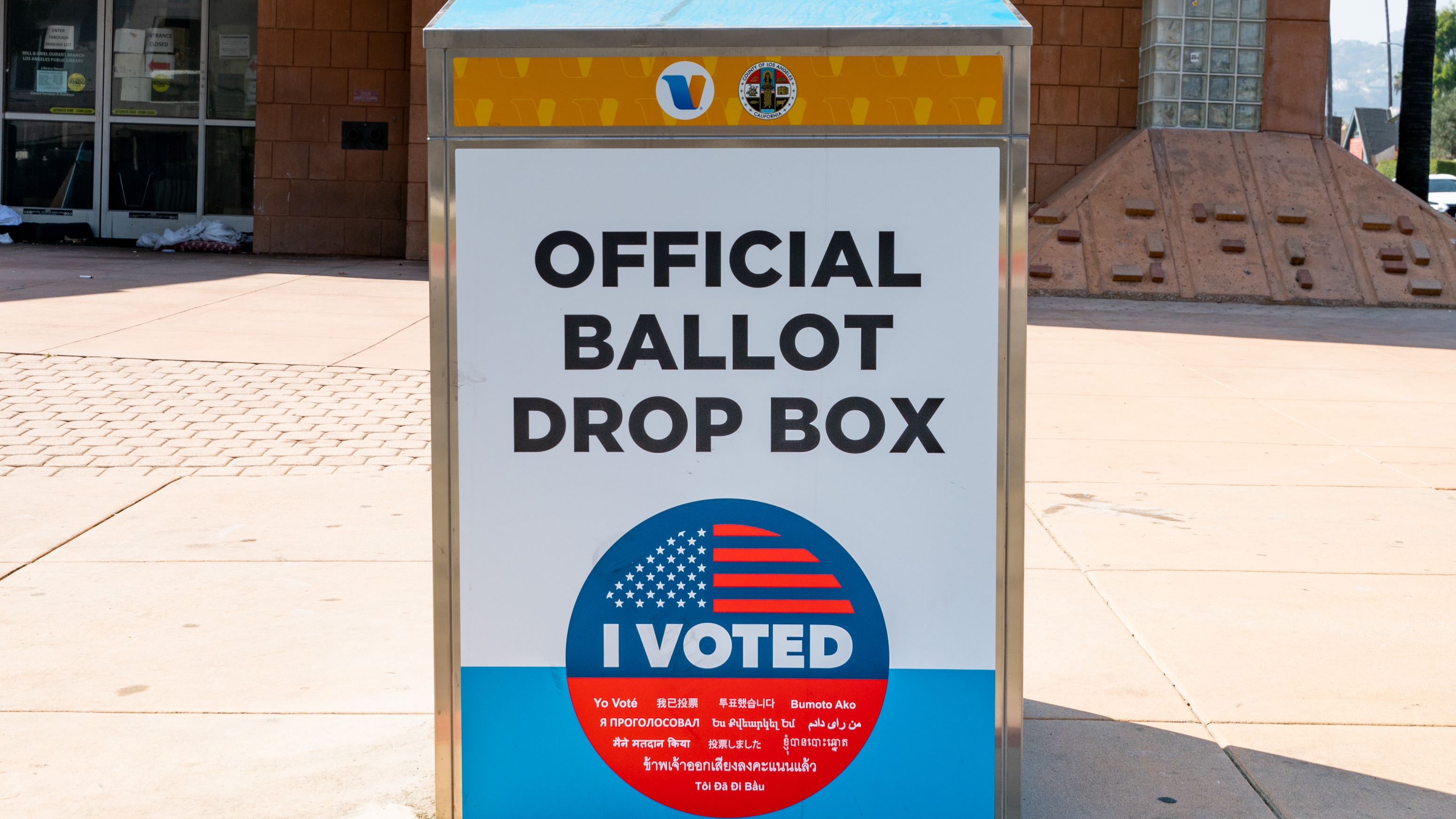Ballot Drop Boxes: A Guide for the 2022 Midterm Elections
Across the country, GOP lawmakers are restricting access to them as yet another form of voter suppression.


Although there was no evidence of widespread voter fraud in the 2020 election—which has been confirmed again and again and again—limiting the use of ballot drop boxes has become the latest effort in the GOP’s attack on voting rights ahead of the 2022 midterm elections. Ballot drop boxes are locked boxes often monitored by surveillance cameras or election workers during specified hours where voters can drop off their signed and sealed ballots. They were widely used in the 2020 election (and had been in use for many years prior) as an alternative to mailing absentee ballots in order to avoid USPS delays and voting in person to mitigate the spread of COVID-19. The new drop box restrictions have become yet another form of voter suppression that will harm people across both political parties in the upcoming election cycle.
“It's really creating two Americas,” says Sylvia Albert, director of voting and elections at Common Cause. “One where your vote is attempted to be suppressed and one where you’re being provided with more access to the ballot.”
If you’re concerned about whether or not there are ballot drop boxes in your area and you’re able to use them, find out everything you need to know about ballot drop boxes ahead of the 2022 midterm elections, below.
What Are Ballot Drop Boxes?
Ballot drop boxes are safe, secure steel boxes bolted to the ground that you can drop your signed and sealed ballot in. The number of drop boxes available vary widely by state, and are often located at a main county or city office building, like a public library or City Hall.
What States Have Recently Limited the Use of Ballot Drop Boxes?
There have been a number of states that have limited the use of ballot drop boxes since the 2020 election. Georgia, Iowa, and Florida have limited them by restricting the hours, locations, and number of drop boxes in use. The most drastic measure, however, was taken this summer by the conservative-majority Wisconsin Supreme Court. The state completely banned the use of ballot drop boxes—even drop boxes that were attached to the election clerk’s office—by stating that there was no specific statute that authorized the use of ballot drop boxes.
“This is designed specifically to make sure that many of the absentee ballots that are cast will not be counted simply because they didn't get there in time or were not returned properly,” explains Jay Heck, executive director of Common Cause Wisconsin. “The calculation in Wisconsin by the Republicans is that more Democrats vote by absentee ballot overall than Republicans so they view it in their interests to be able to restrict how absentee ballots are returned. By getting rid of all the drop boxes, their calculation is that this will help them.”
It's important to note, however, that vote by mail was equally used by both parties prior to the Republican party's attack on voting by mail and ballot drop boxes.
Stay In The Know
Get exclusive access to fashion and beauty trends, hot-off-the-press celebrity news, and more.
How Will Wisconsin's Drop Box Ban Affect Other Voting Laws Across the Country?
Heck emphasizes that Wisconsin is a microcosm for the rest of the country. It was once a leader in high voter turnout and expanded access to the ballot prior to the very restrictive 2011 voter ID law and 2022 absentee ballot law that went into effect. "That's why I say Wisconsin's a microcosm because the calculation often is that if we can get away with doing this in a state like Wisconsin, which has a long tradition of open voting, then we can probably do this kind of thing in other states around the country,” says Heck.
Voter education is needed to inform people about these changing laws, which election officials have failed to do, so constituents are taking matters into their own hands. Recently, the Wisconsin ballot drop boxes have been transformed into an art project to inform voters about the bans and where to send their absentee ballots.
What States Have Recently Expanded the Use of Ballot Drop Boxes?
There are a lot of states that have expanded access to vote by mail since the 2020 election, which includes adding ballot drop boxes. Think: states in the northeast like Connecticut, Rhode Island, Massachusetts, and Delaware. This is important as ballot drop box accessibility is key for everyone, but especially disabled voters and elderly people.
"Every voter has different experiences and different limitations, so providing as much access as possible is really the only way to actually meet all of the voters' needs," says Albert.
In February 2022, the Justice Department issued a press release on ballot drop box accessibility requirements under the Americans with Disabilities Act. In the release, Assistant Attorney General Kristen Clarke of the Justice Department’s Civil Rights Division noted, "For too long in our history, many voters with disabilities have faced barriers in exercising their voting rights. Many of these barriers continue even today, including physical barriers that prevent them from entering polling places or accessing a ballot drop box. The ADA requires election officials to select and provide accessible ballot drop box locations so that voters with disabilities can have the same voting opportunities as other voters."
What Are Some Myths About Ballot Drop Boxes?
1) They’re not secure.
This is false. They are steel boxes, usually bolted to the ground, and reportedly more secure than U.S. mailboxes. According to the U.S. Election Assistance Commission (EAC), ballot drop boxes should have the following:
• Video surveillance camera
• Media storage device (for recorded video)
• Decal (branding and information)
• Extra keys for opening slot and access door
• Security seals
2) Once you drop a ballot in a drop box, that ballot can be counted and there are no other security measures.
This is false. The ballots that come through drop boxes go through the same security checks as any ballot that comes through the mail. “Election officials will check, depending on your state, your signature, date of birth, or license number. They're going to ensure that this person hasn't voted already because if they've already voted that ballot's going to be tossed,” explains Albert. “There’s a misconception that, ‘Oh, if a ballot's in the ballot drop box that means it's definitely going to be counted’ and no, security checks happen on all ballots.”
3) Allowing someone else to drop off a ballot on the voter's behalf encourages voter fraud.
This is false as there's currently no evidence to support this. Whether or not a family member, attorney, or caregiver can drop off an absentee ballot on a voter's behalf varies depending on the state they live in. Ballot collection laws by state can be found on Ballotpedia.
How Do I Find My Closest Ballot Drop Box Location, Plus My State's Rules and Deadlines?
You can find a list of ballot return options in your state on USVoteFoundation.org. You can also visit Common Cause or RocktheVote.org. These organizations will direct you to your secretary of state’s website if the information is updated and reliable. However, this probably isn’t the case as these departments often don’t have the resources to adequately inform the public about major changes to their state’s election laws.
What If I Live Near a Ballot Drop Box, But Can't Access It Due to Transportation Issues or Other Factors?
You can still vote by mail (depending on your state's laws) or in person. However, if there's less than two weeks before the election on November 8, 2022 and you still haven't requested or mailed in your ballot, it's recommended to vote in person. Even if you planned to vote in person to begin with, you should double-check your voter registration status to make sure your personal information is up-to-date, so you have no issues at the polls.
Rachel Epstein is a writer, editor, and content strategist based in New York City. Most recently, she was the Managing Editor at Coveteur, where she oversaw the site’s day-to-day editorial operations. Previously, she was an editor at Marie Claire, where she wrote and edited culture, politics, and lifestyle stories ranging from op-eds to profiles to ambitious packages. She also launched and managed the site’s virtual book club, #ReadWithMC. Offline, she’s likely watching a Heat game or finding a new coffee shop.
-
 Trade Your Multi-Step Lip Care Routine for One Do-it-All Gloss
Trade Your Multi-Step Lip Care Routine for One Do-it-All GlossHydration, pigment, and longevity.
By Siena Gagliano Published
-
 I’m Wearing These On-Sale Summer Tops With Everything This Summer
I’m Wearing These On-Sale Summer Tops With Everything This SummerFrom denim to skirts, these under-$150 finds work with everything.
By Brooke Knappenberger Published
-
 My Afro and I Have a Summer Muse—and Her Name Is Kerry Washington
My Afro and I Have a Summer Muse—and Her Name Is Kerry WashingtonMy curls understand the assignment.
By Ariel Baker Published